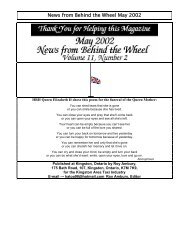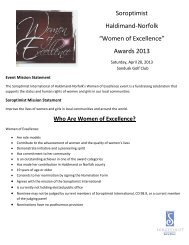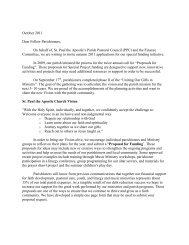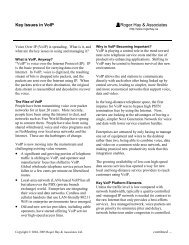SPRING 2006 CanewS PAGE 7Perssonal Reflections on the Collectionby Dick PerssonA treasure – hidden in plain sight!In the museum’s exhibit “It wasn’t all work”the hull of the decked sailing canoe Widgeonhas been exhibited for many years. I have toadmit I have not given this canoe muchthought or study before. However, I recentlyhad reason to take a closer look at the craftand its provenance. I realized that there is astory hidden here that ought to be told. Athorough search of the museum’s storageturned up the parts which were believedlost; the sliding seat, masts, the modifiedNorwegian tiller system, the cockpitsplashguard, the rudder and the centreboard. Unfortunately, Widgeon came tothe museum collection without the sailrigs.It is believed that this canoe was builtby the Wm. English Canoe Co. in partbecause it is known that the WmEnglish built many of the MacKendrickfamily’s canoes. Additionally, there areno builder’s marks on it that I have foundto date. However, this canoe has anumber of construction details which point tothe N. Gilbert Boat Building Co. in Gananoque,Ontario.Nelson Gilbert’s first decked sailing canoeof note was C.E. Archibald’s Mab (shown).Her construction was well documented inseveral articles in the 1890’s. Many more ofthe same design were built over the next 20years.It is most likely, that Widgeon is a sister ofthis successful racing canoe. Future research,smart-scan and a comparison ofWidgeon’s lines to those of other Gilbert builtdecked sailing canoes will tell us more aboutexactly what we have. It is my hope that thisexciting canoe exhibit could be expanded toinclude the additional artifacts which weredonated along with the canoe. The exhibitmight also include the story of itsowners, the famousMacKendrick family.The canoe is whatis known as a 16-30 decked sailingcanoe and wasdonatedby Ms. N. MacKendrick in 1980. Researchindicates that the donor’s father wasJ. N. MacKendrick, one of the threeMacKendrick brothers,John, Will and Harry,competitive canoeistswith a long list ofchampionships to theirnames. They competedfor The Toronto CanoeClub and were early oninvolved with the AmericanCanoe Associationas well as holdingvarious board positionsand executive offices.What is a 16-30 decked sailing canoeTo understand just what a decked sailingcanoe is, one must go back to late 1880’sand early 1890’s and a man named PaulButler. Prior to Butler’s time, sailing canoesactually looked much like everyday cruisingcanoes, about 15 to 16 feet long, halfdecked,and with modest sailing rigs. Inthose early days the canoes had no selfdraining cockpit; it was often unmanageableafter an upset and carried only about sixtysquare feet of sail, with the sailor sitting onthe cockpit edge. Butler, to overcome thedisadvantage of his scant 110-poundweight, devised first the sliding seat to givethat weight greater leverage, the crossheadtiller so he could steer while out on the endof his sliding seat, next the automatic cleatto tend his sheets until he came inboardsand a self-bailing shallow cockpit to keepthe seas out of her.The effects of these inventions beganto be felt from about 1890. At thattime there was practically no limit toany element of the decked sailingcanoe with the exception of lengthand beam. The standard sizes were16 feet overall length and 30 inchesextreme beam; hence the class name16-30. Normally, two sails were carriedwith a total area of about 130 square feetbut in some cases up to around 180 squarefeet were tried.Since that time, rigs have changed andrules have been rewritten, but to this day,Paul Butler’s four innovations; the hikingseat, the crossheadtiller, the automatic cleatand the self bailingcockpit are the distinguishingfeatures of thedecked sailing canoe.I am told that noother type of boat offerssuch thrilling and enjoyablesailing! Imagine -flying at 12 knots, suspendeda foot abovethe waves, four or fivefeet out from your boat on the hiking seatand watching her leap through the seas -keen pleasure indeed!Thank you to D. Miller, J. Summers, andR. MacGregor for contributing information.Other sources quoted; “Canoeing Under Sail”by M.D. Wilt and “Champion Canoes of Today”by R.B. Burchard.
PAGE 8 CanewS SPRING 2006Notices and EventsPlease note:The membership computer has crashed and has been replaced.There are still some “bugs” to be worked out, so please be patient and let us know of any errors in our back-up data.Friday, June 2Lecture POSTPONED.Saturday, June 39:00 AM to 3:00 PM,Johnson PropertySunday, June 112:30 p.m. Grand Portage.Thursday, June 15TorontoFriday, July 76:00 PM, Fraserville, ONAugust 14-18Landscape and Experience: The Work of Lewis Henry MorganDerek Brereton’s lecture will be rescheduled for sometime in the fall.Kawartha Fun Day & CanoeathonPaddle from Lakefield to Peterborough, Volleyball Tournament, boat rides on Little Lake and much more. CCM friends fromKenner Collegiate once again are organizing this fun day. Dwayne James is organizing the First Annual Cardboard CanoeRace – all taking place from the Johnson Property on Little Lake (that’s just North of Beavermeade park).Opening and Dedication, Remembering Temiskaming ExhibitSee article on page 3 for more details.Cocktail Party and FundraiserAnyone in the area interested in attending, call Jim Stewart at (416) 944-9562 or email him at jfcs.cvcc@sympatico.caChairman’s BarbecueFollowing last year’s terrific event, Verne & Pat McKay will again host a barbecue at their barn. Cocktails and hors d’oeuvresstart at 6:00 and the dinner begins at 7:00. A dance will follow. Tickets $100 per person ($60 of which can be used as a taxreceipt). Get your tickets at the Canoe Museum.Summer Institute for TeachersGet your ORCA Flatwater Instructors certification. See Education Report on page 6 for more details.Letter to the EditorTo the Editor:I never was a huge fan of Frank Sinatra but eversince reading Dick Persson's article in the Winter 2006issue of your newsletter ("Perssonal Reflections on theCollection) I can't get one of the famous ditties by "OldBlue Eyes” out of myhead…"Regrets I'vehad a few, but thenagain, too few tomention.. . "I'd like to mentionone regret that hit melike a whack on theside of the head afterreading Persson's fullpage article about thehistory of theStephenson canoesof Peterborough:I met Gerry andMary Stephenson in the mid 1970s' through my wife,Kris. We continued to enjoy a three decade-long friendshipwith the Peterborough couple who were avid cottagersand canoeists, especially on Lake Chandos andAnstruther Lake. Gerry taught me the J-stroke in 1974when I didn't know the front end from the back end of acanoe. As a young buck, I probably thought a J-strokewas a method of cleaning a canoe with a J-cloth!Gerry passed away on September 17, 2003 and Krisand I still keep in regular touch with Mary, but I regret thatI never questioned Gerry for more details about hisMary and Gerry Stephenson canoeing at theirAnstruther Lake cottage in 1979.family's canoe-building history. It is now a missed opportunity.I once asked an elderly gentleman if he had anyregrets in his life and he said, "Yes. Just one. I wish Ihad been more curious." And that's just how I feel now,nearly three yearsafter Gerry's death.But, thankfully,Dick Persson'scolumn waspublished in yournewsletter and Ilearned new detailsof the family history,especially about tworare canoes thatGerry donated to theCanoe Museum. Onewas made by Gerry'sgrandfather, John S.Stephenson, who was once described by the PeterboroughExaminer as "the Father of the Peterboroughcanoe." The other artifact is a 17-foot canvascoveredcanoe made by Gerry’s uncle, George R.Stephenson.Among the many fascinating things I learned in Persson'sarticle was the fact that John Stephenson inventeda paddle-making machine that reduced much of thehand-work in the process of paddle making. Also,George Stephenson produced more than 500 boats andcanoes until his death in 1945. I did not know that! Imight have, had I been more curious and asked morequestions during our visits to Mary and Gerry's cottageat Anstruther Lake, and more recently at their vacationhome in Lagoon City.In November 1987, Gerry wrote a 24-page pamphletthat was published by the Peterborough HistoricalSociety titled, "John Stephenson and the famousPeterborough Canoes. " I recall scanning the bookletnearly 20 years ago, and more recently I was honouredto receive a complimentary copy from Mary, atGerry's funeral on September 20, 2003. But it took DickPersson's fascinating article to pique my interest inlearning more about Gerry's family history of canoemaking. Regrettably, Gerry is no longer with us, so Icannot get any more first-hand information from my oldfriend and canoe teacher, but I have now becomesomething that Lewis Carroll wrote in Alice Through theLookrng Glass: curiouser and curiouser.In his 1987 pamphlet, Gerry noted that his grandfatherwas born 103 years before him. He wrote, "I hadno opportunity to ask him questions of the fascinatinghappenings during his times." Gerry was born a mere13 years before me and I had the opportunity to askhim a lot more than I did about his family's history. Youcan bet I'll be re-reading his booklet and watching formore canoe stories by Dick Persson in your newsletter.Thanks for publishing his article.Sincerely,Dennis McCloskeyRichmond Hill, Ontario
















